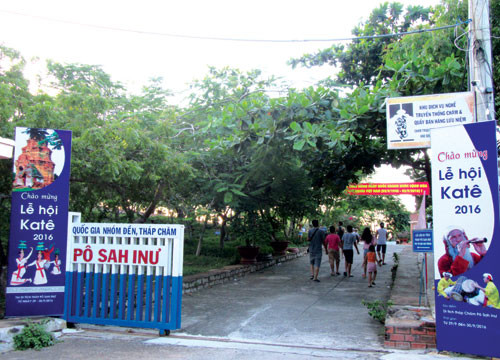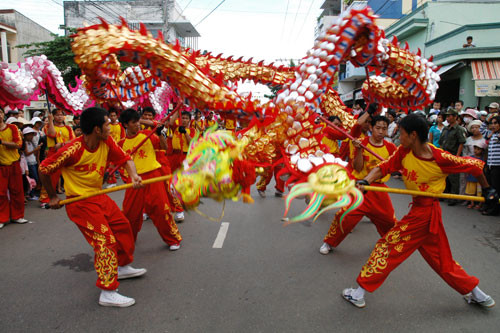1. The best position of Cham village is the gate in the direction of Southerly Mountain matching with the Cham Idiom: “Cơk mưraung, kraung birak” meaning “Mountain to the South and River to the North”. Unlike the living style of the Kinh people, gate and a house-to-house distance are quiet wide. Houses are arranged following the style of ‘Gop’ which is divided into family branch (or ‘Ciet Prauk’). During the process of cohabitation, certainly, some other Gops randomly appear and mix into the prior community. Their houses are arranged lines by lines in parallel with a wide and straight path for some ox-carts movement. These paths interconnect together by smaller alley, called “Chet”.
The houses of Cham People are always surrounded by fences made of wood or bamboo in the past but concrete wall nowadays. The entrance is South-facing. Guess has to take some more steps from the “Chet” to get access the house’s entrance and interior.
 |
| The house of Cham People |
2. There are one or several families living together in a block of Cham’s houses (Cham’s Sang), which usually includes five rooms in different location upon their functions. Sang Yo, a name of a first house in the village, was first built in south-west direction on the purpose of living and carrying out other family customs. Sang Muyuw stands opposite to Sang Yo, its large door heads to the South going over Sang Yo. Sang Twai or Sang Halom are used for receiving guests or guest stay. Sang Gan (horizontal house) has door facing the East, connecting to Sand Yo’s gable end. Sang Ging (i.e. Kitchen) is isolated from others, sometimes hidden from behind Sang Gan.
In addition, Cham people put up some good space in convenient area around the house for storage of rice mill underneath, agro-fisheries processing tools and other equipment above. Cham people can dispose luffa or gourd trellis if there is more space available. When looking at the overview of the Cham’s house, guests will feel weird seeing few trees’ shadows, especially big trees despite this scorching and rain-rare region. The reasons are their anxiety of thunder storm in the central region and their scare of ghost stay. Thus, the tree will be cut down when there is someone in family getting sick.
3. So should a guest keep off when visiting a Cham’s house? Yes, absolutely. Each ethnic group has its own custom! Foremost, the corpse is not allowed to bring into the village if the death triggered somewhere outside of the village. In case of co-living between Cham people and Kinh people, it’s possible to take in but the disinfectant ceremony will be done traditionally after that. Next, if a wild animal, called ‘con do’ (scientific name: ‘Muntiacus muntjak annamensis’) (or ‘nhjrwah’ in the Cham language), unfortunately, strays into the village, the village holds cleaning ceremony then. For the Cham Ba Ni, they don’t eat pork, so raising pigs in fences is not allowed, let alone bring pork home.
Despite of poverty, Cham people often offer real property to dead person instead of fake one as usual (even just used for burning). They believe that the lives in the afterworld are similar to the living world. They also have faith in the existence of ghost. In order to drive ghost away, Cham people usually hang the 2 ceramic pots plastered with white lime on both sides of the entrance. During one-month parturition, branches of cactus are hung at the gate as a signal of birth-giving. The Cham people also light fire in the mid-yard to both prevent evils and maintain hygiene.
The Cham people do not only take care of such big matters above, other gossip like mat-laying is also paid attention. If the mat is unrolled in wrong direction, it is supposed that nobody sits on. It is compulsory to put the mat facing the east-west direction but not north-south, the opposite direction, which is considered as a direction of placing dead body.
The foregoing information is enough for you to visit a Cham’s house without any troubles. “Twai tamư paga yuw ba mưda tamư sang” means “as guest comes, well-off omen comes. Why do you still hesitate to visit a Cham’s house?
My Thien (Source: Binh Thuan Newspaper)


















.jpg)





.jpeg)

.jpeg)


.jpeg)


